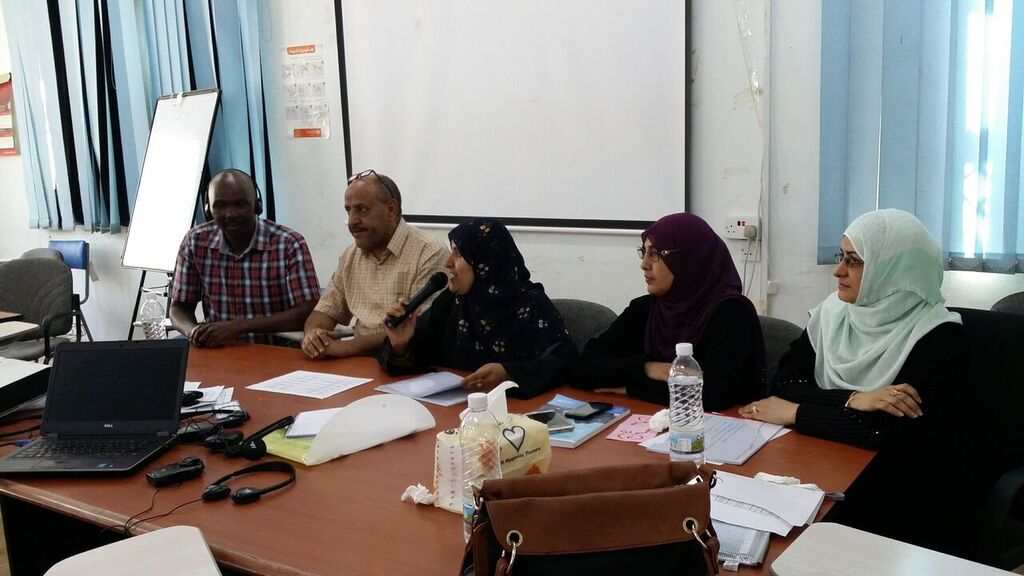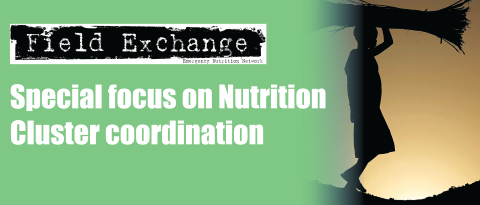Tech RRT CMAM Adviser: Experiences from Nigeria and Yemen
By Simon Kiarie Karanja
Simon Karanja is a nutritionist with over ten years’ experience in nutrition in emergencies, holding various positions in NGOs, UNICEF and the Global Nutrition Cluster in Kenya, Somalia, Uganda, Sudan, Ethiopia, Sierra Leone and DRC, specialising in CMAM programming, cluster coordination and information management.
The findings, interpretations and conclusions in this article are those of the authors and do not necessarily represent the views of USAID/OFDA, UNICEF or others.
Nigeria
Technical area: CMAM
Location: Maiduguri, Borno State, Nigeria
Period: 3 August to 9 September 2016
Requesting agency: International Medical Corps (IMC)
Host agency (in-country): IMC
The purpose of the Technical Rapid Response Team (Tech RRT) deployment to Maiduguri, Nigeria, was to support the Ministry of Health (MoH), non-governmental organisations (NGOs), and United Nations (UN) partners to strengthen and scale up the emergency nutrition response through community-based management of acute malnutrition (CMAM) technical capacity building, response coordination, and monitoring and evaluation. The mission was requested, organised and hosted by the International Medical Corps (IMC) Nigeria country office and involved a 50-50 split between direct support to the IMC nutrition team and support to the collective, including the Nutrition Sector.
Key deployment deliverables included:
- A CMAM/infant and young child feeding (IYCF) six-day training for 25 MoH, seven IMC, four Norwegian Refugee Council (NRC) and three Mercy Corp staff. IYCF was included in the context of CMAM to mainstream IYCF support in treatment;
- Support for the UNICEF nutrition programme section to develop a micro-plan for the integration of mid-upper arm circumference (MUAC) screening and mobile outpatient therapeutic programme (OTP) sites to treat severe acute malnutrition (SAM) cases ‘on the spot’ within a planned mass polio vaccination campaign;
- Support for the State Nutrition Officer (SNO) (Nutrition Sector Coordinator) to map and produce the first 4W (who, what, where, when) of CMAM programmes and to carry out a gap analysis;
- Technical capacity building of the SNO and two assistant SNOs to effectively plan and conduct programme monitoring, supportive supervision and mentoring. This included a review of CMAM supervision checklists and the planning of a joint sector supervision and mentoring mission (including UNICEF, NGO partners and government nutrition staff); and
- Technical support to the SNO to establish and coordinate the activities of a CMAM technical working group (TWG), including drafting of the TWG Terms of Reference (TOR) and meeting management.
The deployment also involved technical capacity building for the IMC nutrition team on OTPs, blanket supplementary feeding programmes, IYCF and care group programming through on-the-job coaching and technical briefs, as well as technical capacity support on mass MUAC screening (including micro-planning, data analysis and reporting).
Several challenges were faced during the deployment, likely linked to it being among the first undertaken by the Tech RRT. The TOR would have benefited from more input from the Nutrition Sector or MoH; while it included objectives focused on all stakeholders, effort was duplicated in practice with some overlap in roles between the SNO and Tech RRT. In addition, UNICEF brought in three staff through its surge mechanism to assist the sector on CMAM, which caused some initial confusion. - partners were not clear on whom to submit reports/4W to or whose directions to follow and the SNO was overwhelmed by the different sources of ‘support’. Eventually the National Nutrition Sector Coordinator, based in Abuja, was moved to Borno state level to assist and harmonise coordination. These challenges highlight the importance of good coordination and consultation in the development of TORs.
There were also challenges in this deployment in balancing host agency demands with those of the collective Due to unforeseen human resource developments in IMC at field level, additional support to national IMC staff was necessary to help manage the IMC nutrition programme. IYCF and care group programming – both IMC priorities – were also added to the TOR on arrival in the field, likely crossing the line into support to agency specific responsibilities. This impacted on time available for the collective and reinforced the general perception within the Nutrition Sector that the support was largely for the host agency; there was reduced demand from the collective as a result.
The training proved an excellent opportunity to introduce current CMAM technical knowledge and best practice to MoH health staff and to allow them to benchmark their CMAM skills and practices with those of other countries with more established CMAM programmes, such as Ethiopia.
Given the dynamics and the many stakeholders involved in sector coordination in Borno, it was necessary to use networking and persuasion skills to demonstrate the Tech RRT’s capabilities and show added value within the Nutrition Sector. This included initiating or suggesting activities valuable to the collective, such as compiling the 4W and gap analysis; encouraging cooperation from the SNO; and providing SNO support behind the scenes.

Yemen
Technical area: CMAM
Location: Sanaa, Yemen
Period: 29 January to 9 March 2017
Requesting agency: Nutrition Cluster
Host agency (in-country): IMC
The main objective of this deployment was to provide technical support and capacity building to Nutrition Cluster members. This focused on the review and update of the national CMAM guidelines and protocols. The mission was requested by the Nutrition Cluster Coordinator (NCC).
Key deliverables included:
- A redrafted interim guideline on CMAM, steered by the Nutrition Cluster Strategic Advisory Group (SAG). This included updating the guideline with current technical knowledge and best practice, a review of monitoring and evaluation (M&E) tools and simplifying the guidelines to make them user-friendly and action-oriented. Support was also provided to the Ministry of Public Health and Population (MoPHP) to organise and conduct a workshop to review the redrafted guidelines. The workshop’s output was collated into the new draft guidelines/protocols;
- Organising and leading of a joint monitoring mission of stabilisation centres (SCs), OTPs and targeted supplementary feeding programmes (TSFPs) in three hospitals in Sanaa urban. Observations and recommendations were shared and discussed with cluster members;
- A review of and recommendations for the UNICEF/World Health Organization (WHO)/World Food Programme (WFP) scale-up plan on CMAM. The suggestions included innovations to increase CMAM coverage, such as expanded admission criteria; a combined SAM/moderate acute malnutrition treatment protocol; and MUAC measurement by mothers. Particular consideration was given to implementation through local NGOs with limited capacities. The reviewed document was shared with the NCC as these agency specific plans aim to align with the cluster plan; and
- Working with the Tech RRT IYCF adviser on IYCF integration into the CMAM guidelines. This included mainstreaming IYCF in all chapters and inclusion of a specific IYCF section to ensure referral to IYCF services.
The deployment also provided OTP/SC training, focused on monitoring and supervision training and on-the-job coaching for IMC (host agency) staff (16 in total; 12 in Sanna and four in Ebb).
The Tech RRT role to facilitate the review of the Yemen CMAM guidelines was well received and appreciated by partners and the MoPHP. The Tech RRT adviser acted as a neutral arbitrator between stakeholders, some of whom were keen to influence the review process to bring the result closer to their existing Standard Operating Procedures (SOPs) rather than find collective ways of working in response to the needs of the whole sector.
There were also challenges in adopting the suggestions for innovation during the final stages of the guideline review. Barriers cited by participants included low technical capacity to adapt/implement innovations; lack of evidence of impact of innovations in the Yemeni context (and lack of related guidelines available in Arabic); and lack of resources to support new initiatives such as expanded admission criteria.
Tech RRT arrival in Yemen coincided with a transition in the leadership of the Nutrition Cluster and the overlapping of an incoming and outgoing NCC; this required careful balancing of the different working styles of the two cluster leaders. Working closely with the national-level Nutrition Cluster SAG and the MoPHP and maintaining a neutral position were both critical to a successful deployment.
In Yemen there was some friction between the host agency (IMC), the Nutrition Cluster and MoPHP regarding how the Tech RRT adviser’s time was used for sector-wide versus agency-specific demands. Due to the physical proximity of the Tech RRT adviser to the host agency staff, it is understandable how this dynamic developed.
Reflections from both deployments
In both countries (and in many other instances) support for CMAM programming is closely linked with or integrated into the overall Nutrition Cluster/Sector coordination activities. While this is positive, it does create a potential for overlap or duplication with the cluster’s role in existing acute malnutrition treatment programming; this overlap can be avoided with good coordination between the adviser and the cluster as well as with well-defined TORs.
In Nigeria, as outlined earlier, the TOR would have benefited from greater input from the Nutrition Sector or MoH, which resulted in duplicated activities and coordination as well as confusion among stakeholders as to who had ultimate responsibility. There was also limited awareness within the Nutrition Sector of the role and responsibilities of the Tech RRT adviser. These issues also led to initial challenges in creating space within the cluster mechanism to support CMAM rollout effectively.
In Yemen the initial TOR included activities that could not be completed within the short deployment duration and would have been better implemented over a longer period as part of the overall cluster coordination process. For example, the original TOR included bottleneck analysis of cluster partner capacity and development of a cluster preparedness and contingency strategy and plan. From experience, these activities would likely take more than the six-week duration of the mission. The decision to remove them from the TOR was supported by the Nutrition Cluster members.
The overall challenge of identifying CMAM technical capacity and activity (gaps) is not easily addressed within the overall cluster coordination process. In Yemen this was a challenge due to restricted movement, making it impossible to visit CMAM sites or even the NGOs/MoPHP/health facilities to assess their capacities. In addition, NGOs operating in some locations (particularly those in Al Qaeda-held areas) do not participate in the cluster coordination mechanism and there is minimal participation from those operating outside the major towns. It is also very difficult in Yemen to collect information remotely as email is limited. The political and administrative fragmentation makes it difficult to coordinate or bring together all the actors on nutrition/health issues.
In both deployments, the nutrition partners indicated that the Tech RRT resource was ideal to deliver CMAM training, either as a training of trainers or directly to health facility/NGO staff. Staff training is expensive for NGOs and collaborating with health facility staff and joint training significantly reduces the cost. The Tech RRT is arguably in a better position, with greater flexibility, to conduct on-the-job training/mentoring and to provide remote support, compared to consultants frequently used.
The Tech RRT CMAM adviser role may vary by situation. For example, in the initial phase of a sudden-onset emergency, the role may be focused on coordination (scale-up) with less time spent on technical issues. In chronic emergencies, Tech RRT technical skills may be better utilised to improve programme quality and coverage, mentoring and monitoring support.
For more information, contact: Simon Karanja


